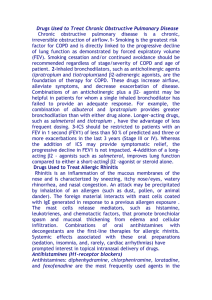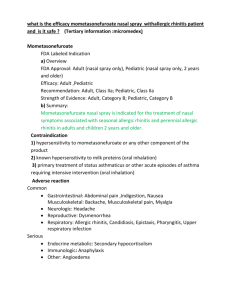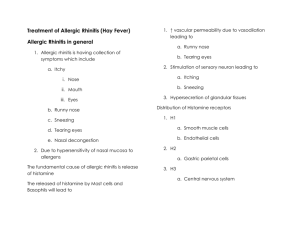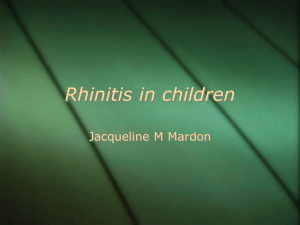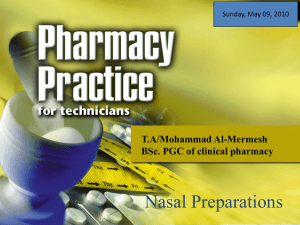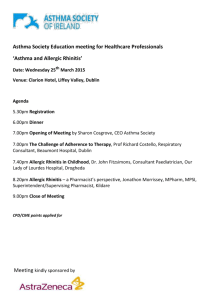Chapter 30 Drugs Used to Treat Upper Respiratory Disease
advertisement
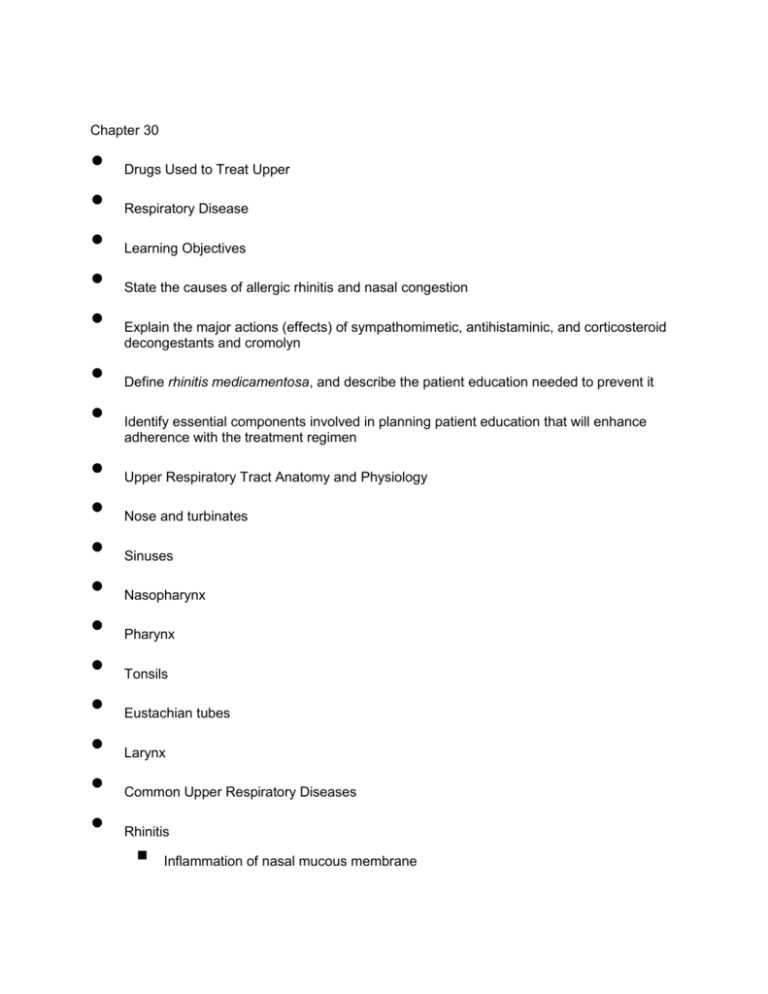
Chapter 30 • • • • • • • • • • • • • • • • • Drugs Used to Treat Upper Respiratory Disease Learning Objectives State the causes of allergic rhinitis and nasal congestion Explain the major actions (effects) of sympathomimetic, antihistaminic, and corticosteroid decongestants and cromolyn Define rhinitis medicamentosa, and describe the patient education needed to prevent it Identify essential components involved in planning patient education that will enhance adherence with the treatment regimen Upper Respiratory Tract Anatomy and Physiology Nose and turbinates Sinuses Nasopharynx Pharynx Tonsils Eustachian tubes Larynx Common Upper Respiratory Diseases Rhinitis Inflammation of nasal mucous membrane • • • • • • • • • Caused by common cold, bacterial infection, presence of foreign body, druginduced congestion (rhinitis medicamentosa) Allergic rhinitis Caused by allergic reaction Releases large amounts of histamine Treatment of Upper Respiratory Diseases Common cold Limited to relieving symptoms Antihistamines are of some benefit Analgesics, antipyretics, expectorants, antitussive agents also beneficial, depending on cold symptoms Treatment of Upper Respiratory Diseases (cont’d) Allergic rhinitis Identify allergens (skin testing) Avoid exposure, if possible, to allergens Treat with antihistamines, decongestants, intranasal antiinflammatory agents Use saline nasal spray to reduce nasal irritation Treatment of Upper Respiratory Diseases (cont’d) Rhinitis medicamentosa Prevention is best treatment Withdraw topical decongestant Nasal steroid solutions also can be used Nursing Process for Upper Respiratory Diseases Assessment • • • • • • • • • • • • • Description of symptoms History of treatment History of concurrent medical problems Planning Symptoms and treatment Implementation Patient Education and Health Promotion Patient understands importance of adequate rest, hydration, personal hygiene Discuss specific medications prescribed Patient understands when to take medication Patient Education and Health Promotion (cont’d) Explain proper technique in administering medications Teach patient to monitor temperature, pulse, respiratory rate, and blood pressure, as appropriate Learning Objectives Explain why all decongestant products should be used cautiously in people with hypertension, hyperthyroidism, diabetes mellitus, cardiac disease, increased intraocular pressure, or prostatic disease State the premedication assessments and nursing assessments needed during therapy to monitor therapeutic response and side effects to expect or report from using decongestant drug therapy Learning Objectives (cont’d) • • • • • • • • • • • Review the procedure for administration of medications by nose drops, sprays, and inhalation Sympathomimetic Decongestants Actions Stimulate alpha adrenergic receptors of nasal mucous membranes causing vasoconstriction Uses Relieve congestion associated with rhinitis Administered orally or topically as nasal spray Therapeutic outcomes Reduced nasal congestion, easier breathing Nursing Process for Sympathomimetic Decongestants Premedication assessment Check patient history Take baseline vital signs Planning Availability Administration Nose drops, nasal spray Nursing Process for Sympathomimetic Decongestants (cont’d) Evaluation Side effects to expect • • • • • • • • Mild nasal irritation Side effects to report • Hypertension Drug interactions • Drugs that enhance toxic effects Methyldopa, reserpine • Concurrent therapy not recommended Antihistamines Actions Compete with allergy-liberated histamine Reduce symptoms of allergic reaction Uses Systemic treatment of allergic rhinitis and conjunctivitis Best taken on scheduled basis Therapeutic outcomes Reduced symptoms of allergic rhinitis Nursing Process for Antihistamines Premedication assessment Review patient history for glaucoma, prostatic hyperplasia, asthma Assess patient’s work environment Individualize patient assessment with underlying pathologic condition Planning • • • • • • • • • • • Implementation Nasal spray, tablets/capsules, syrup, injection, suppository Nursing Process for Antihistamines (cont’d) Side effects to expect Sedative effects Cognitive impairment Drying effects Fluid intake Blurred vision, constipation, urinary retention; dryness of mouth, throat, and nasal mucosa Drug interactions Central nervous system (CNS) depressants Learning Objectives Explain why all decongestant products should be used cautiously in people with hypertension, hyperthyroidism, diabetes mellitus, cardiac disease, increased intraocular pressure, or prostatic disease State the premedication assessments and nursing assessments needed during therapy to monitor therapeutic response and side effects to expect or report from using decongestant drug therapy Learning Objectives (cont’d) Review the procedure for administration of medications by nose drops, sprays, and inhalation Intranasal Corticosteroids Actions • • • • • • • • • • Exact mechanism that reduces inflammation is unknown Uses Given to patients who don’t respond to antihistamines or sympathomimetic agents Therapeutic outcomes Reduced rhinorrhea, rhinitis, itching, sneezing Nursing Process for Intranasal Corticosteroid Therapy Premedication assessment Treat blocked nasal passages with topical decongestant just before beginning intranasal corticosteroids Patient blows nose thoroughly before administering Planning Availability Nursing Process for Intranasal Corticosteroid Therapy (cont’d) Implementation Nasal aerosol, nasal spray Counseling Preparation before administration Maintenance therapy Evaluation Side effects to expect—nasal burning Cromolyn Sodium (Nasalcrom) Actions Antiinflammatory agent that inhibits release of histamine • • • • • • • • Uses In conjunction with other medications to treat severe allergic rhinitis Therapeutic outcomes Reduced rhinorrhea, itching, sneezing Nursing Process for Cromolyn Premedication assessment Taken before exposure to stimulus that initiates attack of allergic rhinitis Determine if concurrent use of antihistamines or nasal decongestants has been ordered Patient blows nose thoroughly before administering Planning Availability Nursing Process for Cromolyn (cont’d) Implementation Nasal spray, nasal aerosol Counseling Evaluation Side effects to expect • Nasal irritation Side effects to report • Bronchospasm coughing No drug interactions reported
